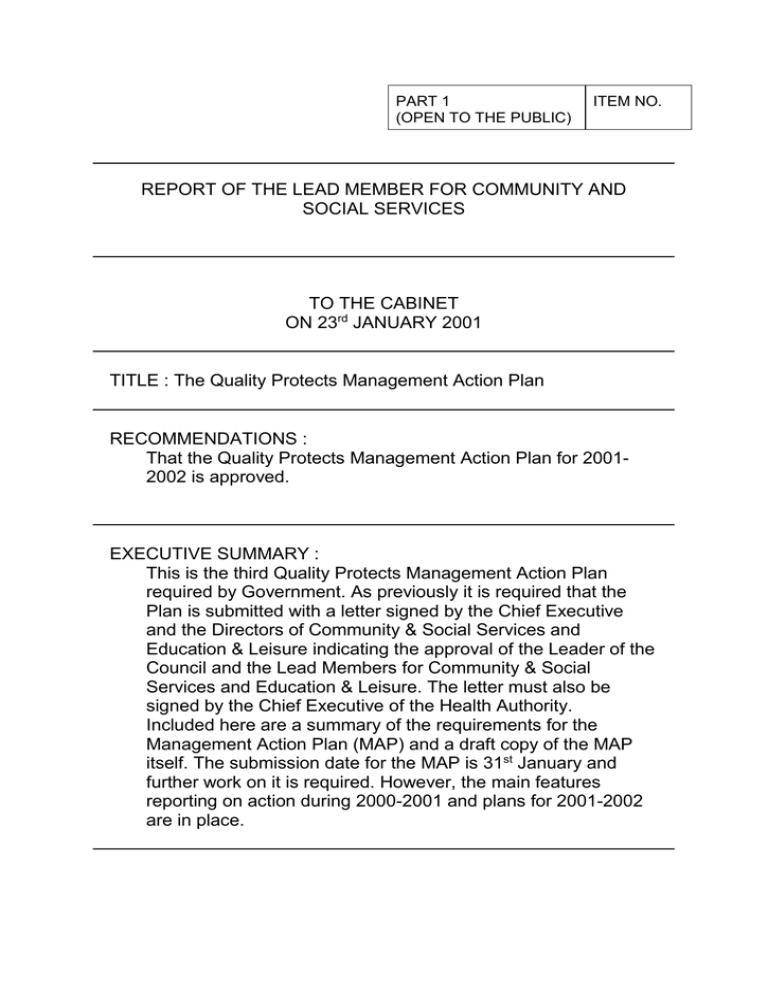REPORT OF THE LEAD MEMBER FOR COMMUNITY AND SOCIAL SERVICES
advertisement

PART 1 (OPEN TO THE PUBLIC) ITEM NO. REPORT OF THE LEAD MEMBER FOR COMMUNITY AND SOCIAL SERVICES TO THE CABINET ON 23rd JANUARY 2001 TITLE : The Quality Protects Management Action Plan RECOMMENDATIONS : That the Quality Protects Management Action Plan for 20012002 is approved. EXECUTIVE SUMMARY : This is the third Quality Protects Management Action Plan required by Government. As previously it is required that the Plan is submitted with a letter signed by the Chief Executive and the Directors of Community & Social Services and Education & Leisure indicating the approval of the Leader of the Council and the Lead Members for Community & Social Services and Education & Leisure. The letter must also be signed by the Chief Executive of the Health Authority. Included here are a summary of the requirements for the Management Action Plan (MAP) and a draft copy of the MAP itself. The submission date for the MAP is 31st January and further work on it is required. However, the main features reporting on action during 2000-2001 and plans for 2001-2002 are in place. BACKGROUND DOCUMENTS : (Available for public inspection) Local Authority Circular (2000)22 Local Authority Social Services Letter (2000)18 CONTACT OFFICER : Paul Woltman 793 2243 WARD(S) TO WHICH REPORT RELATE(S) N/A KEY COUNCIL POLICIES: Quality Protects Management Action Plan DETAILS (See Overleaf) 2 Priorities for Quality Protects 2001-2002. Each year the Government has identified spending priorities for Quality protects. For year three spending has been directly associated with the eleven national objectives for social services for children, and eight of them are spending priorities. Six are covered by the main grant Objective 1: Increasing the choice of adoption, foster and residential placements for looked after children, including appropriate choice for black and ethnic minority children. Particular attention should be given to the new PSA target to maximize the potential of adoption as placement option for looked after children; to the recruitment of adoptive parents and foster carers; and to the implementation of the foster care standards and the Code of Practice. Within this priority, you should separately identify planned expenditure on adoption. Objective 4: Improving the life chances of looked after children through expenditure on their education, with particular attention to implementing the joint DH/DfEE Guidance on the Education of Children and Young People in Public Care and to working towards the PSA targets health needs: working with health agencies to deliver a holistic service to meet the range of looked after children’s physical and emotional health needs as outlined in the consultation document Promoting the Health of Looked After Children, including reducing teenage pregnancy and supporting teenage mothers and fathers in the light of Teenage Pregnancy (SEU 1999) reducing offending and working towards the PSA target on offending and more and better cultural, leisure and sports opportunities and the necessary support to take advantage of those opportunities Expenditure should not substitute for services which properly should be provided or are being provided by local education authorities and the health service, though expenditure on voluntary sector provision to complement such services is acceptable. Objective 7: Improving assessment, planning and record keeping. Particular attention should be given to the inter3 agency implementation of the Framework for Assessment of Children in Need and their Families and Working Together to Safeguard Children. Objective 8: Participation of children, young people and their families in the planning and delivery of services and in decisions about their day-to-day lives. Particular attention should be given to the involvement of young people collectively and to enhancing their individual voices, for example through the development of independent advocacy services. Objective 10: Managing change: expenditure in this priority area should be targeted on human resource issues, communications and on work to strengthen the governance of children's services. Key aspects of HR will include workforce analysis; training and development; effective and safe recruitment; and developing ownership, participation and awareness of multi-agency frontline staff in the Quality Protects programme. Objective 11: Enhancing the development and use of management information systems; improving quality assurance systems to ensure that services are delivered according to requirements and are meeting local and national objectives; and developing financial management strategies. Attention should be paid to how information systems, as they develop, are designed and used to help control for procedural and practice compliance and hence underpin quality assurance. Two other priorities include ring-fenced money as well as the main grant. Objective 5: implementation of the Children (Leaving Care) Bill – subject to Parliamentary approval. Expenditure will provide for improved support for qualifying children and young people in and leaving care. For each young person this support will be based on a needs assessment, agreed with him and set out in his Pathway Plan, including accommodation and maintenance for those aged 16 and 17; general assistance up to the age of 21; help with employment up to the age of 21; agreed programme, even if that takes someone past 21; 4 provision of vacation accommodation (if needed) for someone in Higher Education or in Further Education which means living away from home; provision of young person’s advisers to the age of at least 21, or for as long as someone is being helped with education or training. Objective 6: Services for disabled children: this has been made a priority area for grant because of the body of evidence which shows heavy demand pressures and shortcomings in the provision of services. Expenditure should be targeted on increased provision of family support services including short term breaks; better integration of disabled children into mainstream leisure and out of school services; improved information for planning purposes; better information for parents and the increased availability of key workers and other measures to improve co-ordination. Steps must be taken to ensure that services are appropriate for ethnic minority communities. The Grant. The Quality Protects Grant for Salford for 2001-2002 is £838,551. This is an increase from £669,000 for 2000-2001. However, approximately £100,000 has been removed from the grant to form part of a new ring-fenced grant for children leaving care services which will be paid in line with new responsibilities from October 2001. That grant will total £798,505 but most of it has been taken from the Standard Spending Assessment settlement and is not new money. The ring fenced grant for children with disabilities is £84,560, again not new money but redirected from the general settlement. Much of the spending set out in the MAP for 2000-2001 is ongoing, including items such as strengthening the Family Placement Team, supporting Independent Visitor and Advocacy services, and strengthening the Reviewing Section for Looked After Children. Money from the Grant is also being used to help pay for the new IT system for personal social services, CareFirst. Approximately £380,000 is available for new plans in this MAP. Particular emphasis is placed in this MAP on developing Adoption Services and the Aftercare Service. Both are regarded as very important by the Department of Health and new responsibilities will be introduced in the area of Aftercare in October 2001. Improving 5 the life chances of children looked after is also of great importance and this year it is proposed to reward children who do well at school. Foster care recruitment has been a problem during 2000-2001. Local Authorities were asked to stop local recruitment during the national recruitment campaign. Unfortunately the national campaign had minimum impact (locally and nationally) and our foster carer recruitment has fallen. We have now begun a local campaign, funded by the Health Action Zone, with our HAZ partners. The Government is increasingly concerned that social services are relevant and accessible to children from ethnic minorities and their families. Work is planned in 2001-2002 to ensure our services meet these requirements. Spending on children with disabilities will focus on supporting children and families in the home, although much other work is going on. Salford spends far more than the ring-fenced amount on children with disabilities in a very active partnership with Barnado’s. Preparing the MAP In preparing the MAP work has been done with colleagues from the NHS and the Education & Leisure Directorate, voluntary sector partners who work with us to deliver services (Barnado’s, BGWS, Catholic Children’s Rescue, NCH, Spurgeon’s), and with children and young people. The Government’s emphasis is increasingly on the outcomes of the innovative work undertaken for Quality Protects for children and less on the activity itself. This year we are required to consider our performance in the Performance Assessment Framework (PAF) and identify how we will improve in areas of weakness. In fact, Salford’s performance in the PAF for 2000 was generally between average and good. However, pressure on the looked after system means that it will always be necessary to work hard to maintain good performance. The timetable has been extremely tight. Information on the grant and the pro forma to complete the MAP were both delayed until midDecember. As a result further work is required (eg this year's financial summary and some sections of text). However, there will be no significant changes of emphasis between the attached draft and the final submission. 6

